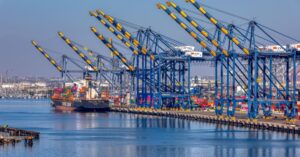Ocean freight is such a critical transportation mode that commerce flat out doesn’t happen without it. It’s estimated that trucks deliver more than 70% of goods domestically, including most of what’s in your home: food, clothing, furniture, you name it. Well, the majority of all that came via a cargo ship steaming from somewhere to the U.S. Pretty much 90% of everything rides along on the seas.
To make all of this happen, at least a metric ton goes on behind the scenes in an extremely complex, highly regulated industry. The logistics of ocean freight are staggering: booking shipments; hauling them into and out of ports; tracking each container from origin to arrival; securing customs clearance; and short-hauling cargo to a nearby rail yard, storage warehouse, or carrier terminal.
Now with the Port of Baltimore closed for an undetermined period of time, the scheduling of ocean freight will become even more challenging, as backups are inevitable. Tens of thousands of twenty-foot equivalent units (TEUs) will have to be transferred via truck and rail from stranded vessels in the harbor to other East Coast ports. Terrorist activity in the Red Sea and a drought in the Panama Canal had already made for a tricky balancing act. This means supply chains are feeling the effects, though to a lesser degree than from other disruptive events. All of which points to the critical need for simplifying the logistics process with a “one-call solution” approach.
Sea vs. Air Transport: Weighing Your Options
Airfreight is the other option for shippers importing goods to the U.S. It’s the more expensive choice for sure, but has the benefit of much faster transit times. Per Freightos, the average standard economy air freight time from China to West coast ports is currently 8-10 days, with expedited saving 2-3 days; ocean freight can range from 14-42 days. But the cost of air freight can run 4-6x that of ocean freight, even higher with full container loads.
In 2023, more than 11 billion tons of cargo moved by ocean freighter globally, more than double the figure of 4 billion tons in 1990. By contrast, an estimated 97.3 million metric tons were moved by airfreight last year, compared to 24 million in 1990. Ocean carriers clearly have a much higher capacity to transport goods, including bulky, non-containerized freight than can be rolled on and off ships.
Considering the lower cost and greater capacity of ocean freight versus airfreight, it’s the clear choice for shippers not needing expedited transportation. From a sustainability standpoint, ocean freight has a significantly lower carbon footprint than airfreight. On a per ton-mile basis, air cargo generates as much as 47x the carbon emissions as ocean freight, making it a much more environmentally friendly long-distance transportation mode.
Ocean freight is generally reliable and cost effective for bulk shipments, but it is susceptible to weather delays and port congestion. Geopolitical tensions, such as those caused by the Gaza war, disrupt shipping lanes and affect global supply chains. The longer transit times can increase exposure to market fluctuations and variations in demand.
Airfreight, with its greater speed and flexibility, is crucial for time-sensitive shipments. But it is more vulnerable to weather disruption and airspace restrictions due to geopolitical tensions. It also has greater capacity constraints, especially ahead of the Q4 holidays as retailers bulk up inventories.
Facing the Challenges of Ocean Freight Management
Navigating through international shipping regulations and customs clearance can be perplexing for shippers. Yes, that’s a bit of an understatement! Here are some key aspects and how they impact the movement of ocean freight.
Paperwork, Documentation, and Communication
There’s a lot of documentation to file, manage, and track on every ocean shipment. This includes the bill of lading, the commercial invoice and the certificate of origin, verifying where the goods are coming from for customs inspectors. Also required is an insurance certificate, an export declaration, a Destination Control Certificate (which lists countries goods can be exported to), and a Shipper’s Export Declaration for merchandise valued at $2,500 or more.
Countries also have their own specific laws, tariffs, and documentation requirements. Both delays and fines can occur when these regulations are not strictly adhered to. This can include misclassification of goods, failure to meet environmental standards, and failure to secure the necessary permits. Thorough planning is required, and assistance of an experienced logistics provider is strongly recommended.
Maintaining clear communication across different time zones and cultures in ocean freight management brings its own set of issues. This includes coordinating operations during overlapping business hours, addressing language barriers, and dealing with each nation’s unique business practices. All of this can mean delays in decision-making and complicated negotiations, impacting supply chain efficiency.
Transshipments and Port Issues
Ocean sailings often involve transshipment, i.e., transferring cargo from one vessel to another. It’s akin to booking a trip with a connecting flight in air travel, as there often isn’t a direct route between origin and destination ports. Shipping lines, port operators, and logistics service providers need to collaborate, coordinate schedules, track cargo, and ensure a smooth transition between vessels. The complex logistics calls for precise timing and communication to maintain shipment integrity and transit timelines.
Ocean freight also means dealing with drayage, specialized transport providers that ferry cargo from off the ship to carrier terminals or nearby storage facilities. The movement of used shipping containers must also be carefully managed, to avoid costly detention and demurrage (D&D) charges from terminal operators.
Port congestion and access is another issue that can crop up at any time. Things have eased up considerably since the freight volume peak in 2022, when dozens of ships sat at anchor for days outside San Pedro Bay leading into Los Angeles, waiting for an open berth. But now the Port of Baltimore is closed, with no resolution in sight, leaving shippers and carriers to scramble and set up workarounds. While not a major port for many types of freight, it is a main entryway for imported trucks, cars, and farm equipment. It is also a main port of entry for dry (coal, grain, ores, sugar) and liquid (petroleum and chemicals) bulk goods. At least one commentator is downplaying the impact, with rerouting to other ports addressing most of the backup.
Much more serious is the ongoing terrorizing of cargo ships transiting the Red Sea. Houthi rebels continue to attack vessels from nations it deems supportive of Israel in the Gaza war, even sinking one of them. On March 25, Houthi missiles struck a Chinese tanker, even though a nonaggression agreement had been reached; the ship was able to continue on its course. Massive amounts of cargo and sailings have been rerouted around the Cape of Good Hope in Africa, adding weeks onto transit times and piling on costs. Maersk and other lines say they will continue a “wait and see” approach before returning to the Red Sea passage.
Conditions have eased somewhat at the Panama Canal, where a severe drought affected the lakes that feed the waterway since 2023, lowering its level, limiting transit and causing backlogs. In mid-March, the Panama Canal Authority added transit slots and looks to add more if water levels improve.
Advances in Ocean Freight Technology
Innovations in tracking, digital documentation, and automated systems have improved the efficiency of ocean freight operations. Advanced GPS and RFID technologies provide real-time visibility into cargo location and condition, enabling faster issue response, betting planning, and more accurate delivery estimates.
Blockchain and cloud-based platforms have streamlined documentation, reducing paperwork and errors. Electronic bills of lading and digital customs clearance speed up processing times and improve security.
Artificial intelligence and machine learning algorithms can analyze historical shipping data to predict trends, improving capacity planning, demand forecasting, and risk management processes.
The Value of One-Call Ocean Freight Solutions
Given the complexities involved in ocean freight shipping, more companies are opting for the simplicity and convenience of a one-call solution. This simply means that a single end-to-end logistics provider handles everything from booking a sailing to container drop-off and pickup, coordination with the ocean line and destination port logistics.
Opting for a one-call solution greatly simplifies the complexities of ocean freight, making it more manageable for shippers. COGISTICS Transportation, with years of experience in all aspects of ocean freight across industries, can save you time, reduce stress, and lower overall costs on every shipment. Have a shipment with a critical timing need? COGISTICS Transportation also offers outstanding, reliable expedited freight services.
Having an experienced ocean freight forwarder like COGISTICS Transportation overseeing every nuance of your shipment provides peace of mind, knowing it’s in very capable hands. We also have the flexibility and skillset to tailor our services to meet the specific needs of each shipment.
Successfully Managing Ocean Freight Shipping Requires a Steady Hand at the Tiller
With myriad details to oversee, market conditions to keep abreast of and disruptions to be dealt with, ocean freight shipping is a challenging environment for veterans and newcomers alike. Even as the Panama Canal situation improves, the Houthi piracy campaign could linger for months, and the potential for East and Gulf Coast port stoppages this fall loom on the horizon.
COGISTICS Transportation, with a lineage that goes back more than 25 years, can meet your shipping needs on land, sea, or air. Our collaborative approach to supply chain and transportation management includes creation of customized workflows designed to fit your unique needs. Ocean freight services can address any cargo needs, including less-than-container-load (LCL), full container load (FCL) and roll on, roll off (RORO). Get in touch with us today to find out more.




